« The source of true science lies in facts. »
Pierre-Claude-Victor Boiste. (French lexicographer and poet) |
Origin and evolution
of communication.
1 – The origins of verbal language :
A – Difficulties encountered in determining the origin of language :
When did language appear ?The origin of human language seems to have always been a subject of great interest : the myth of the Tower of Babel offers an explanation that has endured through the centuries.
However, having emerged in early prehistory, human language developed without leaving any historical traces.
Unlike writing, whose appearance can be dated, oral language leaves no trace. Scientists therefore use indirect methods to try to trace its origins : to do so, they put forward theories, gather information from past history (tools, population migrations, skull analysis, etc.) and cross-reference it with current knowledge (communication in babies or great apes, etc.).
Today, language has become the subject of multidisciplinary study, which is still struggling to provide answers. Although humans seem to be the only species to possess language, the brain regions associated with it are also found in other primates.
Animals also use language, but it does not consist of words. Sounds and behaviours replace words, performing a communication function similar to human communication in everyday life.
We often confuse articulate language (specific to humans) with communication, which allows all living species to interact. Articulated language is only one component of communication, as humans are not the only ones who communicate. Animal vocalisations also appear to be a language that is perfectly understandable, even to humans.
 |
 |
Currently, research into the origin of language focuses on both temporal and spatial origins.
a – Temporal origin :
Until the 1980s, the scientific community agreed that language appeared around 40,000 years ago.
This explanation was based on the discovery of cave art, the diversification of tools (blades, harpoons, bone tools, etc.) and the proliferation of burials containing offerings.

Lascaux cave.
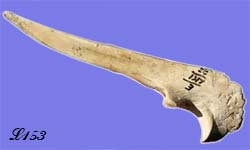
Bone punch.
Other researchers, such as Perreault and Mathew, based on the richness of the language in different phonemes but also on cultural behaviours (burials), believe that human language appeared much earlier, between 350,000 and 150,000 years ago in Homo sapiens.
In addition, archaeological data, such as the construction of huts and the domestication of fire 450,000 years ago, suggest that basic forms of language already existed to coordinate these collective activities.
Today, it is believed that the first forms of language appeared around 2 million years ago.
Indeed, endocranial casts of Homo habilis, who is believed to have lived in East Africa between approximately 2.3 and 1.5 million years ago, reveal the presence of Broca's and Wernicke's areas of the brain, which specialise in language comprehension and development. However, these findings are tempered by other studies showing that this hominid's larynx had not descended and that it was therefore unable to articulate properly..

Chronology of possible appearances of language.
However, in 1989, the discovery of the hyoid bone, which enables vocal articulation, in a Neanderthal skeleton could place the emergence of articulate language well before the advent of Homo sapiens.
However, modern animals that do not have a descended larynx can make themselves understood through vocalisations. The existence of Broca's and Wernicke's areas in Homo habilis could therefore indicate that it was already modulating various sounds without articulating them. We know that Campbell's monkey already uses suffixes even though it does not have articulated language. As for elephants, their ability to communicate through sound is impressive.
(The evidence of the presence of Broca's and Wernicke's areas would then indicate that they only became language areas later, after having been areas of sound communication acting in conjunction with motor areas).

Campbell's monkey.
It is difficult for us, as Homo sapiens, to imagine that our ancestors, Homo habilis (or erectus), were certainly capable of imitating their fellow creatures and even organising community life. This can be understood from the example of the first anthropologist who had to experiment to rediscover the size of flints: but showing his method to a colleague was certainly enough, without further explanation, to pass on this new knowledge..
Due to man's tendency to place himself at the top of the evolutionary pyramid, language has long been considered specifically human. However, one may wonder why man still finds it difficult to recognise the multitude of means of communication perfectly adapted to the needs of the living world as languages in their own right.
b – Geographical origin :
Another way of studying the origins of language is to exploit one of its characteristics : the more different phonemes a language has, the closer it is to the original home of language. This is how Quentin Atkinson, a specialist in language evolution at the University of Auckland (New Zealand), was able to deduce that all languages spoken on earth originated in southern Africa (all territories south of the African equatorial forest).
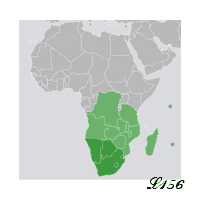
Southern Africa.
According to him, language appeared between 50,000 and 100,000 years ago among Homo sapiens, even before they left Africa, before spreading as they migrated.
c – Anatomical transformations in hominids :
Another way of approaching the origins of language is to formulate hypotheses about its evolution based on environmental constraints and the needs of each species within the different evolutionary lineages.
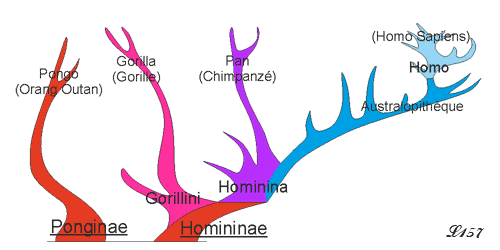
If we consider only human language, we can assume that the emergence of this language dates back to Homo habilis. Indeed, the morphology of its skull, which differs from that of Australopithecus, allows for the development of the areas of the brain involved in articulate language.

Morphology of the hominid skull.
By lowering the upper airways (pharynx and larynx), the straightening of the skull in Homo habilis allowed for the modulation of vocalisation, while the increase in the height of the palate allowed the tongue to articulate a wider range of sounds.
These morphological changes evolved in parallel with the evolution of the nervous system, as no transformation could be functional without the development of the others.
The emergence of these new physiological abilities was certainly accompanied by increasingly complex oral communication, facilitating the organisation of Homo habilis communities.
Later, the gradual increase in brain mass up to Homo sapiens accompanied the development of language areas already apparent in the left hemisphere of the frontal cortex of Homo habilis.

Brain volume of hominids.
However, while this anatomical transformation favoured the emergence of language in hominids, it cannot be the sole determining factor in human language, and other factors must also be considered.
B – Evolutionary factors that enable the development of language :
With the hypotheses formulated, researchers are left with the facts that enable them to understand the emergence of language.In concrete terms, two avenues can be explored:
- the anatomical data that enable the development of language,
- the social context that makes communication necessary.
a – Anatomical data :
1 - The larynx :
In the 1980s, an American researcher, Philip Lieberman, proposed that speech appeared very recently, based on the fact that in humans today, the larynx is located at the back of the throat, in a low position.
This descent of the larynx can be observed during a child's development. In babies, the larynx is initially in a high position (as is the case in chimpanzees), which allows them to suckle while breathing. Then, as they develop, their larynx descends, and they become capable of articulating sounds.
According to P. Lieberman, language therefore appeared with Homo sapiens.
Another distinctive feature of a child's development is that the senses related to communication begin with hearing, taste and touch, before the eyes discover the world after birth. It is then that language develops, starting with the production of sounds, aided by visual recognition. Evolution may stop at this stage for feral children, or evolve towards articulate language through learning to live in society. The first words will then be detected at the beginning of the second year.

Lowering of the larynx in Homo sapiens.
Is this particular anatomical position of the larynx in humans so important for the development of speech ?
We can already reduce the importance attributed to it if we consider that spoken language requires, first and foremost, developed neurological abilities, which are essential to its formation. The respiratory system must be coordinated with the movements of all the components of the vocal apparatus (larynx), lips, tongue, etc. Furthermore, every nuance of speech must be associated with the whole range of emotional experiences, in relation to environmental circumstances.
Given the number of functions involved in this exercise, language could only develop thanks to the emergence of new physical and nervous abilities, each of which took time to become established in the genes.
The myth of a language unique to humans can no longer be invoked today.
On the other hand, there is a clear link between the areas of language and those of visual expression, between the power expressed in cries and the respiratory motor, and between the reproduction of sounds and learning and memorisation.
Each stage must have become established in physiology and bodily structure over the course of millennia.
2 - FOXP2 gene :
The main interest of the existence of this gene is that it has made it possible to date its mutation, which occurred between 100,000 and 200,000 years ago in Homo sapiens. Its presence also indicates that DNA transformation is also involved in all evolutionary processes.

Chronology of possible appearances of language.
Human language, like birdsong, seems to depend on this gene. Indeed, its absence causes learning deficits in birds when it comes to singing and, in humans, articulation difficulties and an inability to acquire certain grammar rules. However, it remains impossible to determine the starting point of the transformation, as the evolution of genes and the needs of the organism occur simultaneously.
Did the gene subsequently determine useful learning and functions, or did the gene evolve in response to environmental needs, as the existence of jumping genes seems to show ?
The absence of the FOXP2 gene only allows us to determine its function in articulate speech, not to determine the moment or the reasons for the emergence of language.
3 – The brain :
The brain controls all linguistic activity. How are the functions of each brain region distributed?
In most people, language processing takes place in the left hemisphere.
The right hemisphere plays a less important role, but it is nevertheless involved in many areas:
- the organisation of information (for example, during a narrative activity),
- affective prosody, i.e. recognising changes in the speaker's voice (intonation, stress, tempo, pauses), which reinforces the content of speech, mainly through its affective tone.
- language comprehension : example of affective prosody.
- In addition, the right hemisphere manages wordplay, humour and metaphors.
The brain therefore remains a vital organ for the creation and organisation of language, but it works in conjunction with other organs that are equally essential for the production of sounds. Language does not therefore depend solely on certain adaptations such as the lowering of the larynx and the involvement of the tongue and lips.
In order to have something to express, one must take into account the external environment, make the connection with memory, and determine what can be said or must be concealed. The brain also controls the lungs, as well as the muscles of the upper part of the vocal apparatus – the throat, mouth and nose. The flow of air is then modulated to produce the different sounds of speech.
This complex system would be useless if it were not complemented by the organs of hearing, capable of decoding sound information.
All these improvements, which occurred on the basis of sound production and reception common to all species, argue for the gradual emergence of language during the evolution of species.
This is how, in the cercopithecus, a family of primates related to ours that includes macaques and baboons, the brain reorganised itself even before it increased in size. This was revealed by a 15-million-year-old cercopithecus skull fossil.
Although its brain was three times smaller than that of its present-day descendants, it already had a folded cortex.
One of its descendants, Campbell's monkey, is now capable of adding suffixes to the vocalisations it emits to signal danger.
Similarly, if we look at Homo habilis, whose pharynx had not descended and who did not have the FOXP2 gene, we can easily imagine that he was able to make himself understood by modulating sounds without needing to articulate them.

Vocalisations in humans.
Perhaps they were even able to articulate them to a certain extent, like a ventriloquist who can do without lip movements and, to some extent, tongue movements.
b – Environmental and social factors that may have contributed to the emergence of language :
All these discoveries do not completely solve the mystery of the emergence of language. Drawing inspiration from the reasons that lead humans to speak today, other theories have been developed, which are of several kinds.
1 - Mimetic origin :
One of the hypotheses proposed by American psychologist Merlin Donald is that the first form of language to appear in Homo erectus was a mimetic language. For example, to refer to an animal, early humans would mimic its attitudes and behaviours.
This relationship with the surrounding world can be seen in the traditional dances of primitive societies. Inspired by wildlife, hunting, war or harvests, these dances are a means of conveying emotions.
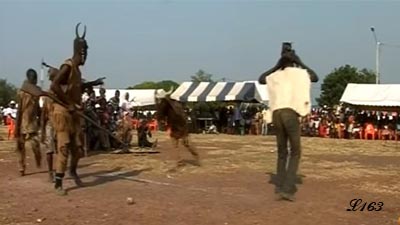
Traditional dance evoking hunting.
Once again (as was the case with the descent of the larynx), we find one of the aspects of a child's evolution, whose development begins with resonance, i.e. the mimetic behaviour that causes them to reproduce the cries of another baby.
Similarly, adults visiting a country whose language they do not know spontaneously adopt mimicry to make themselves understood.

Mimicking the action of eating ice cream.
However, this form of communication, which uses vision, does not allow for the representation of abstract concepts or the evocation of complex situations involving the past or the future. An elaborate language is therefore essential.
2 - Graphic origin :
Here again, vision is essential.
We cannot ignore the fact that the appearance of an object or a living being constitutes a language. Therefore, drawing an object allows us, regardless of location, to express a need and obtain satisfaction.
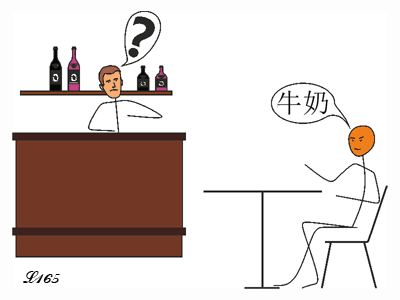
Verbal language.
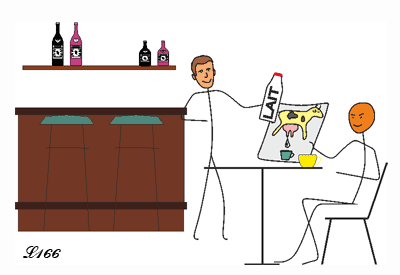
Graphic language.
However, while the images of animals in decorated caves describe life in the surrounding natural environment, and sometimes depict hunting scenes, there are few animals that appear threatening, even if they are dangerous or predatory species.

Hunting scene - Lascaux Cave.
What do images tell us, regardless of their age ?
Objects speak to us first through their form, such as a cup containing a hot drink, and they are situated in an environment : a sword will be protective or deadly depending on its context.

Steaming cup.

Adoubement.
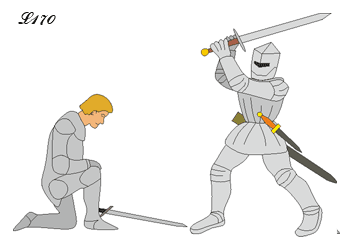
Execution.
Similarly, animals speak to us simply through the image we perceive of them.

The experiences of others are always beneficial.
Communication through images satisfies vital needs, but it remains far removed from the capabilities offered by verbal language.
What becomes of the role of images when they are animated in the gestures of living beings ?
3 - Gestural origin :
This possibility has not escaped researchers. Michael C. Corballis, from the University of Auckland (New Zealand), has proposed a gestural origin of language in Homo habilis. Language expressed through sounds would have been preceded by a gestural language, as is done spontaneously by deaf-mutes, arising naturally from the movements that are part of the activity of all living beings.
Indeed, the anatomical limitations of Homo habilis make it likely that there was a gestural stage that preceded speech, as is the case with children.

The pointed finger indicates the object of interest.
Similar to mime when it simply imitates an animal or a need, sign language proves to be very effective in group activities where speech cannot be used, such as diving.
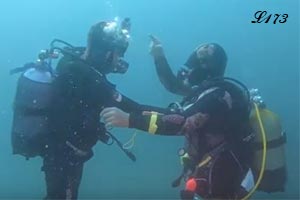
estural communication in diving.
Furthermore, the spontaneous creation of sign language by deaf people provides an argument in favour of gestural behaviour preceding speech. Traces of this remain today in the gestures that accompany our speech.
However, this body language is very different from the elaborate sign language used by deaf-mute people.
But M.C. Corballis' hypothesis does not explain why sign language was abandoned in favour of speech..
Physical development took place in stages, with some organs developing before others.
Thus, the bodily reactions essential for survival appeared first: an amoeba is capable of fleeing from attack or searching for food. The way of moving is therefore the first information that can be interpreted by the senses. Similarly, the simple behaviour of our cat already provides us with a great deal of information about what it is feeling at that moment.
 |
 |
The development of hearing made it possible to be warned of danger that was still invisible.
Then the eyes made it possible to see it.

The rumbling of an avalanche masked by a hedge of trees.

Avalanche
Perception of the environment therefore developed first, before living beings were able to communicate their discoveries.
Humans certainly followed a path identical to that found in child development.
Body language, necessary for vital needs, was naturally supplanted by speech to express thoughts.
4 - Social cement :
According to another theory, social ties led to the emergence of language because a community needs to communicate accurately in order to organise its life. However, it could be argued that bees and ants, despite the organisation of their societies, do not need an elaborate language.
What characterises human language is its extraordinary effectiveness : even today, it manages to transcend the needs of everyday life.
But in doing so, human language reveals the loss of our ability to use our senses, as we increasingly turn to cognitive activities.
5 - Cognitive activities :
How did language come about ?
For American linguist Derek Bickerton, whatever the origin of language, without it there would be no knowledge, no thought and no communication, and therefore no human beings.
This assertion can be supported by the development of the hominid brain : in one million years, the brain, the seat of thought, grew from 400 cm3 to 1,000 cm3 in hominids, which corresponds to the appearance of Homo erectus, the first human to leave Africa and capable of adapting to new environments.
On the other hand, ‘cognitive linguistics’, which emerged in the 1970s, argues that language is dependent on underlying cognitive processes :
It is therefore no longer language that structures thought, but thought that develops language.
According to this hypothesis, language is not a cognitive mechanism that is sufficient in itself. It is the result of a more general intelligence that intervenes in many areas.
Indeed, while discovering the world and learning about life is up to the individual and the use of their five senses, sharing knowledge is difficult without language.
Language therefore multiplies the possibilities for learning. But it does not create this capacity for learning, which can be found in all living beings.
Therefore, despite the importance attributed to it, particularly in the development of knowledge, a question arises : is it language that is importan t? Is it the individual who developed it ? Or is it general evolution, which has proven capable of transforming the living world ?
Indeed, for language to emerge, a set of abilities comes into play: the presence of the senses and an organisation capable of exploiting their abilities. To do this, this system must be able to mobilise others and adapt them to the perception received.
Therefore, thought is needed that is capable of prompting action, memorising the results obtained and anticipating.
A single element is therefore not sufficient for language.
« Communication is the culmination of an evolution that began with the cell
and has been perfected in many directions.
One of its outcomes is verbal language. »
and has been perfected in many directions.
One of its outcomes is verbal language. »
6 - Collective activities :
Apart from the evolution of his anatomy, observing how man has evolved in his environment has provided other answers to the development of his language.
Bifaces the oldest of which were discovered in Africa and date back more than 1.6 million years, are easy to shape without the need for language, as imitation can satisfy the need for elaboration. However, they indicate both the existence of social intelligence and the importance of this object for the community.

musee-prehistoire-eyzies.fr
Later, the construction of dwellings certainly required more elaborate consultation.
Here again, anatomical changes had to keep pace with the evolution of communication needs.
At Terra Amata, on the slopes of Mount Boron near Nice, prehistorian Henry de Lumley and his team studied a 380,000-year-old dwelling built by Homo erectus, large enough for a group of ten to twenty people.
Building such a dwelling required the use of language, even if only rudimentary.

Terra Amata.
It was also during this period that fire was domesticated, marking a more organised social life.
For prehistorians, this social organisation is evidence of language communication, however basic it may have been.
However, while brain size may be linked to the cognitive abilities of hominids, it is not essential for learning simple tasks: as we mentioned with regard to bifaces, it is not necessary to speak in order to light and maintain a fire. The key is to be able to observe and memorise, in addition to having hands and good motor skills.
Observing the sequence of actions accompanied by a few modulated sounds is sufficient. This is how a monkey washing her potatoes was able to pass on her discovery to some of her fellow monkeys without having to teach them the value of her action.
But how can we determine whether it was the tool, i.e. the technique, that preceded language, or vice versa?
It is more likely that language and technique are both expressions of the simultaneous development of multiple abilities.
7 – Other obscure socio-cultural factors :
Experiments conducted by Luc Steels at the Artificial Intelligence Laboratory of the Free University of Brussels have shown that robots can also develop a language with a grammatical structure.
Is the human brain the only one capable of developing language? All scientific disciplines (linguistics, archaeology, palaeontology, anthropology, ethology, genetics and artificial intelligence research) will be needed to try to solve this enigma.
C – The bias of hypotheses :
There is no shortage of hypotheses and facts to determine the origins of language, which may have appeared around 2 million years ago, at the same time as the first tools and the Homo genus.However, apart from deductions made from tangible discoveries, the numerous hypotheses proposed to explain language have one weakness: they approach human language as if humans were the only species to possess it.
First hypothesis : did language develop as an independent module ?
This modular theory of evolution faces one objection : it assumes the emergence of different forms of intelligence at the same time. Each would lead to different abilities : social, linguistic, technical. These forms of intelligence would have appeared in well-defined areas of the brain before merging into a general intelligence.

Brain modules.
A second hypothesis suggests that language is the driving force behind technology and creative intelligence.
However, experience shows that only the social context creates the need to communicate. Nevertheless, the dangers of the surrounding world require intelligence capable of adapting behaviour. The brain needs to be intelligent in order to learn, compare and experiment before it can even communicate. This is what we see in child development.
However, we can accept that, thanks to language, communicating a discovery opens the mind of the person receiving the information.

Proposing a solution is a source of learning for others.
In a third hypothesis, technical know-how is the origin of language.
This hypothesis therefore assumes that gestural intelligence preceded language and explains its development.
Current research shows that there are links between language and gestural manipulation, including the use of tools. Thus, in humans and monkeys, the system responsible for recognising manual actions is located in the left hemisphere of the brain, in Broca's area, which is responsible for language.

Proximity of Broca's area and motor areas.
Research on sign language among deaf people has shown that the grammar of this mode of communication is as sophisticated as that of spoken language. Furthermore, this language also engages Broca's area, which is very close to the motor areas of the arm and hand.
This theory of the origin of language linked to gestures explains why chimpanzees are able to learn the basics of sign language but not verbal language.
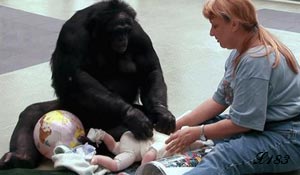
Monkeys learning human language.
This theory, while similar to the modular theory, does not take into account the fact that new words depend both on technical innovations and on the need to transmit them. While words are essential for the organisation of work [cf: Terra Amata], they only come into play after the emergence of community and even after th learning capacity that exists in the first representatives of the living world.It could therefore be argued that, without possessing technical know-how, monkeys have the intelligence that enables them to learn.
Fourth hypothesis : language and technology depend on an underlying mechanism that is specifically human, capable of producing mental representations and adjusting them to the surrounding world.
One might wonder what the origin of this mechanism could be. Could it be part of the theory of a « Great Clockmaker » ?
However, we will see that human evolution is part of the continuum of Evolution.
Yet we do not know the origin of this Evolution, and we are confronted with the inability of our brains to conceive of a universe that occupies infinite space and evolves over time without beginning or end.
Although the origin of human language is difficult to determine, it has left traces of its evolution over time in cave paintings and then in the emergence of writing. Even today, we can observe an almost daily evolution in the transformation, development or disappearance of languages.
By also looking at how images have evolved into writing, we will undoubtedly find elements that will help us better understand dreams.
From verbal language to mathematical languages : (continued)
Du langage verbal aux langages mathématiques (In French)
Bibliography :


